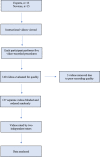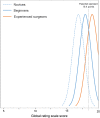Gathering validity evidence for a 3D-printed simulator for training of myringotomy and ventilation tube insertion
- PMID: 37899878
- PMCID: PMC10601587
- DOI: 10.1002/lio2.1123
Gathering validity evidence for a 3D-printed simulator for training of myringotomy and ventilation tube insertion
Abstract
Objectives: This study aimed to gather validity evidence according to Messick's framework for a novel 3D-printed simulator for myringotomy with ventilation tube insertion for use in technical skills training of otorhinolaryngology (ORL) residents.
Methods: The study included 15 junior ORL residents (trainees) and 13 experienced teaching otolaryngologists (experts). Experts and trainees first received an identically structured introduction to the procedure, simulator, and simulation setup. Five procedures performed by each participant were video-recorded and ordered randomly for blinded rating by two independent raters. The rating tools used were a global rating scale (GBRS) and a task-specific checklist. Validity evidence was collected according to Messick's framework. Differences in time consumption and performance scores were analyzed. Finally, a pass/fail standard was established using the contrasting groups' method.
Results: Trainees used significantly more time per procedure (109 s, 95% CI: 99-120) than experts (82 s, 95% CI: 71-93; p < .001). Adjusted for repetition and rater leniency, experts achieved an average GBRS score of 18.8 (95% CI: 18.3-19.2) out of 20 points, whereas trainees achieved an average of 17.1 points (95% CI: 16.6-17.5; p < .001). In contrast to the task-specific checklist, the GBRS score discriminated between repetition number and participant experience. The pass/fail standard for the GBRS was established at 18.4 points.
Conclusion: We established educational validity evidence for a novel 3D-printed model for simulation-based training of ventilation tube insertion and established a reliable pass/fail standard.
Level of evidence: 1b.
Keywords: education; myringotomy; simulation; training; validity evidence; ventilation tube insertion.
© 2023 The Authors. Laryngoscope Investigative Otolaryngology published by Wiley Periodicals LLC on behalf of The Triological Society.
Conflict of interest statement
The authors declare no conflicts of interest.
Figures




References
LinkOut - more resources
Full Text Sources
Research Materials
